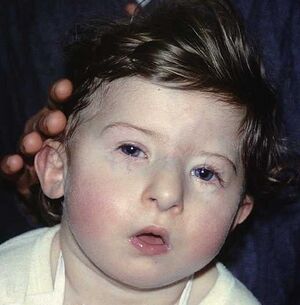DiGeorge syndrome

| Pediatric patient with DiGeorg | |||
|---|---|---|---|
| Clinical picture | Thymic hypoplasia, congenital heart and vascular defects, facial abnormalities, clefts, mental retardation, immune disorders, hypocalcaemia, tetany | ||
| cause | Deletion on the long arm of chromosome 22 (section 22q11) | ||
| diagnostics | Prenatal (biochemical markers, ultrasound markers, karyotype), postnatal (karyotype, clinical picture) | ||
| Incidence in the world | Prevalence of occurrence 1: 3000 | ||
| prognosis | Treatment is symptomatic, the possibility of bone marrow transplantation with peripheral lymphocytes or a transplant from cultured thymic tissue | ||
DiGeorg's syndrome (hypoplasia of the thymus and parathyroid glands, velocardiofacial syndrome (OMIM Template: OMIM), Association OMCH 22 : OMIM) belong to the so - called microdeletion syndromes or contiguous gene syndromes (CGS).
Etiology[edit | edit source]
The most common cause of this syndrome is a deletion on the long arm of chromosome 22 (section 22q11), which is present in 90% of patients with DiGeorg's syndrome. We find the same deletion in two other, phenotypically almost identical syndromes - Taka's syndrome and Shprintzen's syndrome. For DiGeorg syndrome itself, the most typical deletion is 22q11.2 (DGCR - DiGeorge syndrome chromosome region). Cases with a mutation of the T-BOX 1 gene (TBX1) - a specific transcription factor - have been described.
The syndrome occurs mostly sporadically, but cases of familial occurrence are also described, where the syndrome showed an autosomal dominant type of inheritance. In addition to the 22q11 deletion itself, translocations have also been described - e.g. t (2; 22), t (4; 22) or t (20; 22). Characteristic symptoms of this syndrome have also been described for deletions on chromosomes other than the 22q11 region - for example, del (10p13), del (18q21.33) or del (4q21.3-q25).
Due to similar phenotypic manifestations (generally velocardiofacial anomalies) and the same deletion, DiGeorg's, Shprintzen's and Taka's syndrome have recently been classified as CATCH 22 (Cardiac abnormalities / abnormal facies, T cell deficit due to thymic hypoplasia, Cleft palate, Hypocalcemia due to hypoparathy resulting from 22q11 deletion; the acronym CATCH 22 is inspired by the title of Catch-22 by Joseph Heller).
Pathogenesis[edit | edit source]
DiGeorg's syndrome is a disorder in the development of the third and fourth branchial arches, which results in limited development (or complete absence) of the thymus and parathyroid glands. The impairment is variable and the severity of the disease is proportional to the deficiency of T-lymphocytes, which are present only at low levels and in some cases T-lymphocytes may be completely absent. Organ thymodependent areas such as paracortical zones of lymph nodes are also reduced. T-cell deficiency tends to normalize with age, and around 5 years of age, T-lymphocytes may reach normal values. In addition to immune disorders and susceptibility to some viral and fungal infections, the syndrome is also characterized by hypocalcemia (due to the absence of parathyroid hormone) and possible tetany.
The development of the thyroid gland and the ultimobranchial body may also be impaired. Congenital malformations of the heart and large vessels and various abnormalities in the facial region, including clefts, are also typical. Mental retardation is also relatively common.
Clinical picture[edit | edit source]
The clinical picture is variable and affects many organs. They are typical
- common fungal and viral infections resulting from immunodeficiency,
- tetanus cramps, increased muscle irritability, paraesthesia (clinical manifestations of hypocalcaemia),
- congenital malformations of the heart and large vessels (especially the aortic arch),
- cleft facial defects and craniofacial dysmorphia - epicants, sunken nasal root, fish mouth (inverted V shape), shortened philtrum, microretrognation and round wide auricles,
- mental retardation,
- 30-40% small growth.
Therapy[edit | edit source]
Treatment is symptomatic, in more severe cases there is the possibility of bone marrow transplantation with peripheral lymphocytes or a transplant from cultured thymic tissue.
Facial and heart defects can be treated surgically.
Links[edit | edit source]
Related articles[edit | edit source]
- Chromosomal aberrations
- Microdeletion syndroms
- Primary immunodeficiency
External links[edit | edit source]
- JĚŽOVÁ, Marta, Sylva HOTÁRKOVÁ and Katarína MŮČKOVÁ, et al. Hypertext atlas of fetal pathology: Multimedia support for teaching clinical and medical disciplines [online]. Portal of the Faculty of Medicine of Masaryk University [online], © 2008. Last revision 2.2.2010, [cited. 26.11.2011]. ISSN 1801-6103. <http://portal.med.muni.cz/clanek-463-hypertextovy-atlas-fetalni-patologie.html>.
Source[edit | edit source]
- ŠÍPEK, Antonín. Genetic disorders of the immune system [online]. Last revision June 9, 2006, [cited. December 6, 2009]. <http://www.genetika-biologie.cz/primarni-imunodeficience>.
References[edit | edit source]
- BARTŮŇKOVÁ, Jiřina. Immunodeficiency. 1st edition. Prague: Grada, 2002. 228 pp. ISBN 80-247-0244-4.
